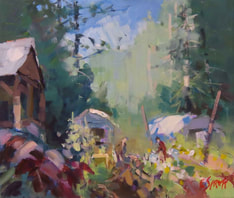 Rideau Woodlands Ramble 10x12 acrylic was painted on a Manotick Art Association Plein Air outing in September. It will be shown at the Amberwood Gallery Show. Too many years ago, I became enchanted with Plein air painting – we called it painting outside – and my enthusiasm for the concept has never receded. It takes a lot of practice before satisfaction begins to set in, and years to perfect it. Many artists paint from photographs for landscape inspiration. Just being outside with sketch book, easel and paints – any medium - has many advantages. A photograph gives us one perspective; when we are outside we stop and look all around. We examine elements from many directions, we observe the brightness of the sky, shifting shadows on the ground and colours that change as we look around, up and down. And, we form an impression. Painting plein air challenges us to record what we perceive – everyone’s different of course - in a way that conveys some inner feeling. Our response depends on our level of knowledge and experience. When we have a concept worked out we begin to paint. The experience can mean dealing with frustration, and enlightenment at the same time and arriving at happy resignation in the case of poor result or incredible ecstasy when the painting is special. Later in studio the work can be refined to enhance the inspiration. Living in Canada affords us four seasons, plenty of opportunity to get out and paint. Charlie October 2022
0 Comments
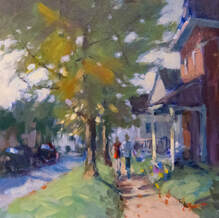 #2221029 The First Day of Fall 16x16 #2221029 The First Day of Fall 16x16 The first Day of Fall! You can see the leaves beginning to turn yellow and there is a fresh smell in the air. It’s a great time to be out and about, as they say, and a wonderful time to paint our Canadian landscape. The Manotick Art Plein Air group have only a few trips left. This one, to Dickinson Square in the ‘Tick’, was particularly lovely because of the sunny weather and it was great just to see people out walking and enjoying the day, particularly after two years of Covid. All plein air artists sense the coming of each season in personal ways. For myself, forty years of living with our growing family in Manotick have engendered many great memories: our family by the river, raking leaves, the children’s first day of school, and walking our dog(s) along back streets are all part of my fall kaleidoscope. When our group came to paint and I walked around Dickinson Square and the Mill, I immediately identified with the tree lined streets and village homes and the strollers enjoying the early morning sunshine. I set up my easel on Mill Street by Dickinson House and my painting developed from there. Charlie September 2022 Early on, when I was busy absorbing everything I could from art books and instructors, I reached the conclusion that the business of painting had a lot to do with expressing one's thoughts about the things we see and experience - a narrative: a method that I preached at all the plein air workshops I taught.
But time has a way of morphing concepts. Serendipitous introductions to certain artists opened doors to fresh ideas. Pausing mesmerized, before an unforgettable abstract work, plied me with a huge respect for non-objectivity. Abandoning oils and solvents for watercolours and acrylics set me on new paths to expression. Watching my grandchildren paint red horses and blue elephants offered “What if?” possibilities. I gained appreciation for high realism, but unless I can discern some significance, other than workmanship, I have little interest in the genre. Instead, I turned to work that combined elements of abstraction and centres of interest. Today, I try to paint work that reflects how I feel about a subject in an intangible way so that my painting invites the viewer to join me, employing their own resources and interests. The tendency for artists to repeat a theme can be compelling if they feel that repetition sells. Many artists, like myself, paint because we feel the need to paint, whatever holds our interest. When I accompany a dozen MAA Plein Air painters outside to paint the landscape, the result is 12 different looking paintings, each one displaying an individual, personal way of seeing nature. In time they will claim their own natural style. To create a sense of a narrative, will take inspiration and fore-thought. Can't wait to start another one. I have a place in mind. . . Charlie August 2022 It's a rainy day at our cottage, two hours drive north-west of Gatineau. The grand kids are busy with crayons and papers flying everywhere. You can barely see across the still lake. The dog wants in. . . Again.
Why don't I just go out and paint something? I can see that the greens, upfront, are vibrant and intense, the hills beyond are blue, fading to grey sky. Still, it's hard to get excited I tell myself, resorting to familiar excuses: I'm getting old, done that before, more boring repetitions, who cares? Wait a minute!. . . There's a break in the clouds - I can sniff a change in the air. Maybe, if I can find an 9x12 canvas? . . I knew some friends, my age, that gave up painting all-together. I couldn't do that. Much of my time is wrapped up in art-connected activities: outdoor painting, assisting artists, meeting clients at art shows, writing blogs like this one for my website and savoured quiet studio time – reworking old work or finishing new canvases while a jazz fm station grooves in the background. Where does this enthusiasm come from? In 50 years of painting I've see a lot, from attending workshops and giving them myself, painting trips and gallery shows. I couldn't be criticized if I decided to retire at this age, right? The courage to paint comes from good health and a caring partner, for which I am grateful every day, and a fountain of wonderful memories. Memories of trips to places like Charlevoix, Gloucester, the Maritimes accompanied by exceptional artist who became life-long friends: Artists that supported my dreams with fresh ideas and mutual high praise, urging me - instilling me, with the drive to go on. Many artists that approach me, these days, are looking for quick solutions to painting problems. I find that I have lost faith in the short answers that I could serve up years ago. Instead, I find words of praise and offer suggestions, offering ways to find courage, practice observation and paint regularly. Reaching new plateaus in one's work comes slowly and in little steps that often go unnoticed until days or months later. I take great pleasure in trying to improve my own work, accepting both good and poor efforts as par for the course. And learning to recognize the difference! Occasionally, I am shown one of my paintings hanging ion someone's home. I am always struck by the professional look of painterly skill and presentation and I feel so glad that I have always sorted and sold only my best work. That moment is an award all by itself! “Hey, the sun is breaking through dark clouds. Let's get out there and see if I can put a different spin on today's work. The roadside flowers are particularly beautiful this summer, I've noticed.” Charlie July 2022 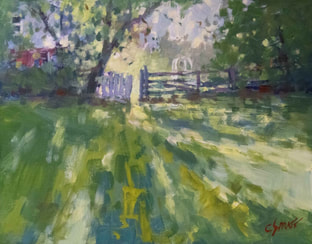 #2221022 The Back Gate 11x14 acrylic #2221022 The Back Gate 11x14 acrylic Setting aside the joys of just being outside experiencing our magnificent countryside in all seasons and sharing the occasional good times with artistic friends, what is it that drives artists like myself to paint outdoors? When you think about it, there are plenty of obstacles to venturing out. Changing weather and freezing temperatures don't make it easy, neither do mosquitoes, black flies, ticks and poison ivy. Makes one wonder - where is the reward? When I set out, loaded with painting gear, I keep an open mind as to a subject for the day, unless I am giving a demonstration for example. When I find a motif that interests me, I like to be free of outside influences so that when I settle in to paint, the time of day, weather and light conditions – all the ambiences - will be at play. That's my mission. Sometimes the process comes easily leading to a quick start. At other times it is evasive – time to move on. This chance process leads to the occasional poor effort. They get discarded. When my instincts all come together, and I record what excites me, I can produce a painting that far exceeds my expectations; the years of painting experience provide me with the means to go beyond detail, to listen to my inner voices and to allow the painting to sail on without conscious effort. And when at last, I put down my brushes, I feel exhausted, drained. I pack up my paints with a big smile and a warm feeling of deep satisfaction. The painting, The Back Gate, (above) is a case in point. On a sunny day in June, I came cross an unusual gate in the forest. A brilliant sun was lighting up the background and garden grounds beyond. I was mesmerized by the effect. Who would use the gate? Why did someone go to the trouble to carefully make it and install it into the the old log fence? In short time I had an idea for a painting. I had enough to make my own story. And no, I don't just like plein air painting – I love it! I hope that my paintings show it. Charlie June 2022 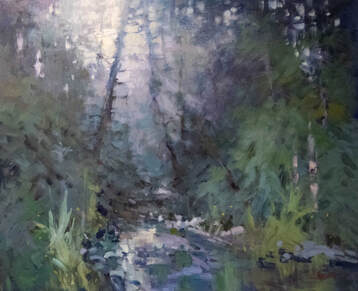 #219922 Summer Morning Along Poole Creek 30x36, repainted. Back in the summer of 2019, before COVID 19, I painted Summer Morning Along Poole Creek from a 11x14 plein-air sketch. The painting captured the day very well, in my assessment, but I always felt that it was dark: faithfully recording the silhouetted trees and shadows and the closed in feeling of the stream and surroundings.
This spring we were blessed with a surprisingly quick recovery from the cold dark days of winter as the snow disappeared and green buds arrived practically over night. I walked the trail daily, revelling in warm weather, watching as the trees and undergrowth changed and the creek receded. I took photographs and made sketches to record the welcome transformations. When I had the time, following the successful 10-Collective art show at the Mississippi Valley Textile Museum in Almonte, I took out Summer Morning Along Poole Creek, removed the 30x36 canvas from its picture frame and set it up on my easel. I studied it with fresh eyes. I asked myself, “could I repaint it using the pent up synergy of this spring?” The risk: that there's no going back. At first I started in tentatively, trying small strokes of green in varying shades of higher values. Then left it on the studio easel for a week or so. Finally, when I felt the excitement of anticipation building, I squeezed out a full palette of Golden acrylic colours. Using Golden Glazing medium and large brushes, I began work in earnest until the canvas was transformed, all the while constantly walking back and forth from my easel to assess the overall effect. Adjustments followed with several trips to Poole Creek at different times in the day to observe shadows, reflections and new greens. When I put down by brushes a further two weeks later, I felt satisfied that I had lifted the painting to a new high. You see, as I often explain to others, I believe that painting is about technique – for sure, but it is also about listening to yourself and expressing those thoughts in an artistic, meaningful way. And never stop trying to do better. . . . Charlie May 2022 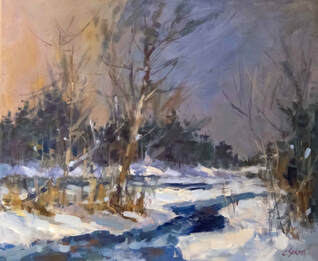 #2221016 Suspended 20x24 acrylic on canvas #2221016 Suspended 20x24 acrylic on canvas The Mississippi River passes through the town of Almonte, winding it's way northwest to the Village of Blakeney, where it transforms into fast-flowing rapids. Standing near the bridge overlooking the rapids, I sense the immense power in the turbulent water at my feet, before it disappears, plunging down in wild waterfalls: the sounds roaring in my ears, creating a sensation of time in suspended animation. My imagination drifts back to earlier times in history when Blakeney was a lively thriving centre with water turbines, mills, stores, shops and homes located close by. Now, a few rusted parts at the entrance to the path going down to the waterfalls are visible. Yet, the river continues it's journey as if time itself was inconsequential. Plein air painting locations often have a special effect on me: a feeling that despite all my worldly cares and efforts at keeping busy, my life is just one insignificant part of this incredible, natural world and then I take comfort in the thought that I am so lucky to be out here, grasping at the enormity and beauty of it all. And feeling so very THANKFUL. #2221016 Suspended 20x24 was created in my studio in early March this year, between multiple trips back and forth to Blakeney for photography and sketching reference material, on late afternoons when the low winter sun's rays warm cold skies. Charlie March 2022 This painting and others will be featured at my booth at the Ten Ten Collective Art Exhibition at the Mississippi Valley Textile Museum in Almonte, Saturday, April 23 and Sunday April 24, 2022. All are welcome. Covid restrictions will apply. I wish I had a new paint brush for every time I have been asked “How long does it take you to make a painting?” I stumble for an answer trying not to seem disingenuous or flippant. In the case of a plein air 11”x14” sketch, from set-up to packing up takes 11/2 hours or so, not counting the time driving to a location and choosing the right spot plus hours of studio work in some cases.
In the case of a large studio piece, there are numerous contributing factors. Firstly, the inspiration for the work may take weeks or longer before it morphs to the concept stage, followed by composition planning and scaling choices ( ie: 20''x24'' landscape or 40”x40” square) in an effort to create the best statement. Often it means returning, when possible, to the sketching location to reaffirm the original intent. As a result, there could be many hours invested before there's a brushstroke on a canvas. Some might suggest that the conception and planning stages are not part of the actual painting process; I would argue that they are, in fact, integral. It is paramount that as artists, we take time to examine our own impressions and thoughts as we go about creating and sharing our story. Once the painting takes form on my canvas, it might only be one or two days to set out the basic layout. Then, there is the process of back-checking the sketches to make sure the painting has the element of truth in it, followed by trial and error corrections and adjustments. Finally, the painting is hung where it can be observed from time to time to make sure it can survive repetitive examinations. In the case of First Light - Version II (above), the inspiration came from recollections of a trip to Algonquin Park some years ago with artist friends when the outside temperature dropped to -40 and I painted a canvas by looking out a cabin window . on Oxtonque Lake. Using that painting as a reference, I began work on a 30x40 canvas this January to show the solitude and energy of the Park in the grip of a cold January day. That painting, unfortunately, did not survive the repetitive examination test. And so, the process began all over again using a smaller 24x24 canvas. I feel satisfied now, that I got the feeling right this time. It has past scrutiny and received my signature. How many hours to make a painting? The answer: it is not important. Only the final result counts. Charlie January 2022 Artists ask me about using acrylics. Often or not, they are interested in trying another medium or looking for an alternative to oil paints and solvents. Many years ago, when I developed an allergy that forced me to stop painting with oils, acrylics were not available and I turned to watercolours. Year's later, I experimented with new acrylic products when they appeared in art stores and I quickly learned to appreciate their many benefits. At first it was all new to me. The painting skills that I developed, with oils and watercolours, helped me to make the transition. Still, I sensed that acrylics were not receiving the respect reserved for oil paintings by artists and the public at large.
But times have changed. Acrylic paint has replaced most of the traditional jobs in our daily life that were done using oil-based paint and any gap between the price of an acrylic painting and an oil has disappeared. I discovered that the combination of professional, light-fast pigments and the versatile, polymer emulsion make for an extremely flexible permanent medium. By some accounts, acrylics are now the most popular artist medium in the world! Yes, acrylics do dry quickly, specially on a hot summer day, and they are affected by cold temperatures in winter, when painting outside. It's a matter of the artist adopting to the medium. There are a multitude of techniques applicable with this modern-day medium: dripping, pouring, glazing, air brushing and mixed media , just to name a few, achieving incredible effects applied to a wide range of supports. The work is dry in 10 minutes allowing for corrections and changes as the painting continues. Packing up to travel is easy and quick; the clean up with soap and water is a bonus. Personally, I prefer good old-fashion brush strokes on stretched canvas, using professional grade heavy body acrylics, synthetic brushes, water and an acrylic glazing medium. Time to get back to my studio and grab a brush. . . . Charlie December 2021 One place that draws me back to paint in all seasons, is Mount St. Patrick in the Highlands of Renfrew County. Since it is only a 20 minutes drive from Calabogie, I made several painting trips there on days when our PAE group stayed at the Calabogie Peaks Resort this past October.
There is something special there - a sense that time stands still. I am drawn to it by the placid, peaceful Constant Creek winding through the small community with its striking old church and ancient burial grounds. But more than that, I can feel the presence of the heritage left by the Irish settlers that found this place nestled deep in the Madawaska Hills and made it their home. Would some of the gigantic trees that line the creek have been witnesses to the thriving community with two stores and a blacksmith shop at one time? As I paint I imagine some of the hardships faced by the pioneers and the wonder they must have felt from the natural world surrounding them. I am told that A.Y Jackson visited Mount St. Patrick as a painting location when he painted the Opeongo Trail from Renfrew to Algonquin Park in the 1950 – 60's, while living in Manotick and Ottawa. Charlie November 2021 Sources: www.ayjacksontrail.ca, Google: Mount St. Patrick Community Ontario |
C. SprattThe Art of Charles Spratt Categories |
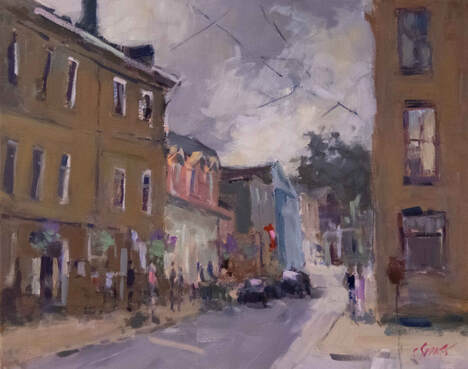
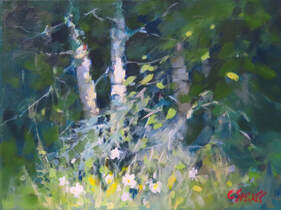
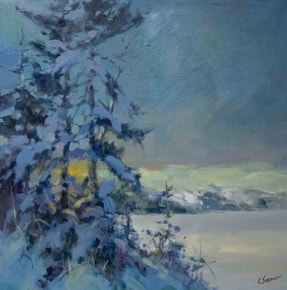
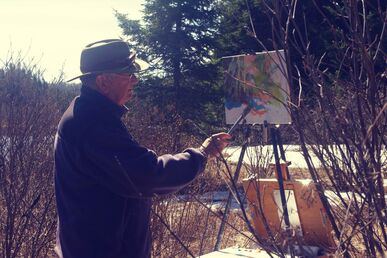
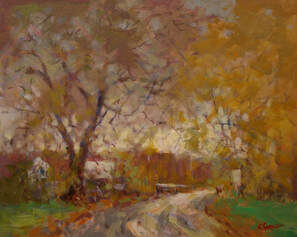
 RSS Feed
RSS Feed